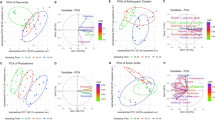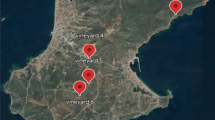Abstract
The influence of growing season (winter vs. summer) on the flavonoid accumulation and composition was studied in the skins of three grape cultivars for two consecutive years under a two-crop-a-year viticulture practice in Southwest China. The total anthocyanin, flavonol and flavan-3-ol contents in winter berry skins were significantly higher than those in summer berry skins for ‘Kyoho’ and ‘Muscat Hamburg’. Reversely, the content of anthocyanin in ‘NW196’ winter berry was lower than summer berry. However, the percentage of diglycosylated, trihydroxylated, methylated, and acylated anthocyanins, trihydroxylated and methylated flavonols, and flavan-3-ol polymers were higher in the summer berry skins than the winter berry skins among all the three grape cultivars. Winter climatic conditions were favorable to flavonoid accumulation for the non native grapes ‘Kyoho’ and ‘Muscat Hamburg’, while the summer climatic conditions were beneficial to anthocyanin accumulation for ‘NW196’ that has 50% genetic background from a local wild grape species Vitis quinquangularis. These seasonal variations of flavonoid accumulations and compositions in the grape skins were primarily contributed by different climatic factors, such as temperature, solar radiation, and rainfall.
Similar content being viewed by others
References
Bergqvist J, Dokoozlian N, Ebisuda N (2001) Sunlight exposure and temperature effects on berry growth and composition of Cabernet Sauvignon and Grenache in the central San Joaquin Valley of California. Am J Enol Vitic 52:1–7
Castellarin SD, Pfeiffer A, Sivilotti P, Degan M, Peterlunger E, Di Gaspero G (2007) Transcriptional regulation of anthocyanin biosynthesis in ripening fruits of grapevine under seasonal water deficit. Plant Cell Environ 30:1381–1399. doi:10.1111/j.1365-3040.2007.01716.x
Chorti E, Guidoni S, Ferrandino A, Novello V (2010) Effect of different cluster sunlight exposure levels on ripening and anthocyanin accumulation in Nebbiolo grapes. Am J Enol Vitic 61:23–30
Cohen SD, Tarara JM, Kennedy JA (2008) Assessing the impact of temperature on grape phenolic metabolism. Anal Chim Acta 621:57–67. doi:10.1016/j.aca.2007.11.029
Cohen SD, Tarara JM, Kennedy JA (2012a) Diurnal temperature range compression hastens berry development and modifies flavonoid partitioning in grapes. Am J Enol Vitic 63:112–120. doi:10.5344/ajev.2011.11015
Cohen SD, Tarara JM, Gambetta GA, Matthews MA, Kennedy JA (2012b) Impact of diurnal temperature variation on grape berry development, proanthocyanidin accumulation, and the expression of flavonoid pathway genes. J Exp Bot 63:2655–2665. doi:10.1093/jxb/err449
Deluc L, Quilici D, Decendit A, Grimplet J, Wheatley M, Schlauch K, Mérillon J-M, Cushman J, Cramer G (2009) Water deficit alters differentially metabolic pathways affecting important flavor and quality traits in grape berries of Cabernet Sauvignon and Chardonnay. BMC Genom 10:212. doi:10.1186/1471-2164-10-212
Downey MA, Harvey JS, Robinson SP (2004) The effect of bunch shading on berry development and flavonoid accumulation in Shiraz grapes. Aust J Grape Wine Res 10:55–73. doi:10.1111/j.1755-0238.2004.tb00008.x
Downey MO, Dokoozlian NK, Krstic MP (2006) Cultural practice and environmental impacts on the flavonoid composition of grapes and wine: a review of recent research. Am J Enol Vitic 57:257–268
Esteban MA, Villanueva MJ, Lissarrague JR (2001) Effect of irrigation on changes in the anthocyanin composition of the skin of cv Tempranillo (Vitis vinifera L) grape berries during ripening. J Sci Food Agric 81:409–420. doi:10.1002/1097-0010(200103)81:4<409:AID-JSFA830>3.0.CO;2-H
Fujita A, Goto-Yamamoto N, Aramaki I, Hashizume K (2006) Organ-specific transcription of putative flavonol synthase genes of grapevine and effects of plant hormones and shading on flavonol biosynthesis in grape berry skins. Biosci Biotechnol Biochem 70:632–638. doi:10.1271/bbb.70.632
Fujita A, Soma N, Goto-Yamamoto N, Mizuno A, Kiso K, Katsumi H (2007) Effect of shading on proanthocyanidin biosynthesis in the grape berry. J Jpn Soc Hortic Sci 76:112–119. doi:10.2503/jjshs.76.112
Haselgrove L, Botting D, van Heeswijck R, Høj PB, Dry PR, Ford C, Iland PG (2000) Canopy microclimate and berry composition: the effect of bunch exposure on the phenolic composition of Vitis vinifera L. cv. Shiraz grape berries. Aust J Grape Wine Res 6:141–149. doi:10.1111/j.1755-0238.2000.tb00173.x
He J-J, Liu Y-X, Pan Q-H, Cui X-Y, Duan C-Q (2010) Different anthocyanin profiles of the skin and the pulp of Yan73 (Muscat Hamburg × Alicante Bouschet) grape berries. Molecules 15:1141–1153. doi:10.3390/molecules15031141
Jin Z-M, He J-J, Bi H-Q, Cui X-Y, Duan C-Q (2009) Phenolic compound profiles in berry skins from nine red wine grape cultivars in northwest China. Molecules 14:4922–4935. doi:10.3390/molecules14124922
Kennedy JA, Matthews MA, Waterhouse AL (2002) Effect of maturity and vine water status on grape skin and wine flavonoids. Am J Enol Vitic 53:268–274
Margaret AC, Marjoire CK, Jimmy S (2007) Anthocyanin, phenolic composition, colour measurement and sensory analysis of BC commercial red wines. Food Res Int 40:92–100. doi:10.1016/j.foodres.2006.08.002
Matus JT, Loyola R, Vega A, Peña-Neira A, Bordeu E, Arce-Johnson P, Alcalde JA (2009) Post-veraison sunlight exposure induces MYB-mediated transcriptional regulation of anthocyanin and flavonol synthesis in berry skins of Vitis vinifera. J Exp Bot 60:853–867. doi:10.1093/jxb/ern336
Mori K, Sugaya S, Gemma H (2005) Decreased anthocyanin biosynthesis in grape berries grown under elevated night temperature condition. Sci Hortic Amsterdam 105:319–330. doi:10.1016/j.scienta.2005.01.032
Mori K, Goto-Yamamoto N, Kitayama M, Hashizume K (2007a) Effect of high temperature on anthocyanin composition and transcription of flavonoid hydroxylase genes in ‘Pinot noir’ grapes (Vitis vinifera). J Hortic Sci Biotechnol 82:199–206. doi:10.1080/14620316.2007.11512220
Mori K, Goto-Yamamoto N, Kitayama M, Hashizume K (2007b) Loss of anthocyanins in red-wine grape under high temperature. J Exp Bot 58:1935–1945. doi:10.1093/jxb/erm055
Price SF, Breen PJ, Valladao M, Watson BT (1995) Cluster sun exposure and quercetin in Pinot noir grapes and wines. Am J Enol Vitic 46:187–194
Ristic R, Downey MO, Iland PG, Bindon K, Francis IL, Herderich M, Robinson SP (2007) Exclusion of sunlight from Shiraz grapes alters wine colour, tannin and sensory properties. Aust J Grape Wine Res 13:53–65. doi:10.1111/j.1755-0238.2007.tb00235.x
Roby G, Harbertson JF, Adams DA, Matthews MA (2004) Berry size and vine water deficits as factors in wine grape composition: anthocyanins and tannins. Aust J Grape Wine Res 10:100–107. doi:10.1111/j.1755-0238.2004.tb00012.x
Romero P, Gil-Muñoz R, del Amor FM, Valdés E, Fernández JI, Martinez-Cutillas A (2013) Regulated deficit irrigation based upon optimum water status improves phenolic composition in Monastrell grapes and wines. Agric Water Manag 121:85–101. doi:10.1016/j.agwat.2013.01.007
Sandhu AK, Gu LW (2010) Antioxidant capacity, phenolic content, and profiling of phenolic compounds in the seeds, skin, and pulp of Vitis rotundifolia (Muscadine Grapes) as determined by HPLC-DAD-ESI-MS. J Agric Food Chem 58:4681–4692. doi:10.1021/jf904211q
Sofoa A, Nuzzoa V, Tatarannia G, Manfrab M, De Niscoc M, Scopa A (2012) Berry morphology and composition in irrigated and non-irrigated grapevine (Vitis vinifera L.). J Plant Physiol 169:1023–1031. doi:10.1016/j.jplph.2012.03.007
Spayd SE, Tarara JM, Mee DL, Ferguson JC (2002) Separation of sunlight and temperature effects on the composition of Vitis vinifera cv. Merlot berries. Am J Enol Vitic 53:171–182
Tarara JM, Lee J, Spayd SE, Scagel CF (2008) Berry temperature and solar radiation alter acylation, proportion, and concentration of anthocyanin in Merlot grapes. Am J Enol Vitic 59:235–247
Tian Q, Giusti MM, Stoner GD, Schwartz SJ (2005) Screening for anthocyanins using high-performance liquid chromatography coupled to electrospray ionization tandem mass spectrometry with precursor-ion analysis, product-ion analysis, common-neutral-loss analysis, and selected reaction monitoring. J Chromatogr A 1091:72–82. doi:10.1016/j.chroma.2005.07.036
Wang H, Race EJ, Shrikhande AJ (2003) Characterization of anthocyanins in grape juices by ion trap liquid chromatography-mass spectrometry. J Agric Food Chem 51:1839–1844. doi:10.1021/jf0260747
Xu C-M, Zhang Y-L, Cao L, Lu J (2010) Phenolic compounds and antioxidant properties of different grape cultivars grown in China. Food Chem 119:1557–1565. doi:10.1016/j.foodchem.2009.09.042
Xu C-M, Zhang YL, Zhu L, Lu J (2011) Influence of growing season on phenolic compounds and antioxidant properties of grape berries from vines grown in subropical climate. J Agric Food Chem 59:1078–1086. doi:10.1021/jf104157z
Yamane T, Jeong S, Goto-Yamamoto N, Koshita Y, Kobayashi S (2006) Effects of temperature on anthocyanin biosynthesis in grape berry skins. Am J Enol Vitic 57:54–59
Zhao Q, Duan C-Q, Wang J (2010) Anthocyanins profile of grape berries of Vitis amurensis, its hybrids and their wines. Int J Mol Sci 11:2212–2228. doi:10.3390/ijms11052212
Zhu L, Zhang Y-L, Lu J (2012) Phenolic contents and compositions in skins of red wine grape cultivars among various genetic backgrounds and originations. Int J Mol Sci 13:3492–3510. doi:10.3390/ijms13033492
Acknowledgements
This study was funded by the Young Scientists Fund of National Natural Science Foundation of China (Grant No. 31401828), China Agriculture Research System (grant no. CARS-30-yz-2), Bagui Scholar Fund of Guangxi, China (grant no. [2013]3), and Daqing Guiding Program of Science and Technology (Grant No. zd-2016-108) and Guangxi Project for Science and Technology Development (grant no. GuiKeAB16380150). We are grateful to Prof. Changqin Duan, Dr. Jianjun He and Dr. Nana Liang in the Center of Viticulture and Enology, China Agricultural University, for assisting in HPLC–MS/MS analysis of anthocyanins.
Author information
Authors and Affiliations
Corresponding author
Electronic supplementary material
Below is the link to the electronic supplementary material.
Rights and permissions
About this article
Cite this article
Zhu, L., Huang, Y., Zhang, Y. et al. The growing season impacts the accumulation and composition of flavonoids in grape skins in two-crop-a-year viticulture. J Food Sci Technol 54, 2861–2870 (2017). https://doi.org/10.1007/s13197-017-2724-3
Revised:
Accepted:
Published:
Issue Date:
DOI: https://doi.org/10.1007/s13197-017-2724-3




